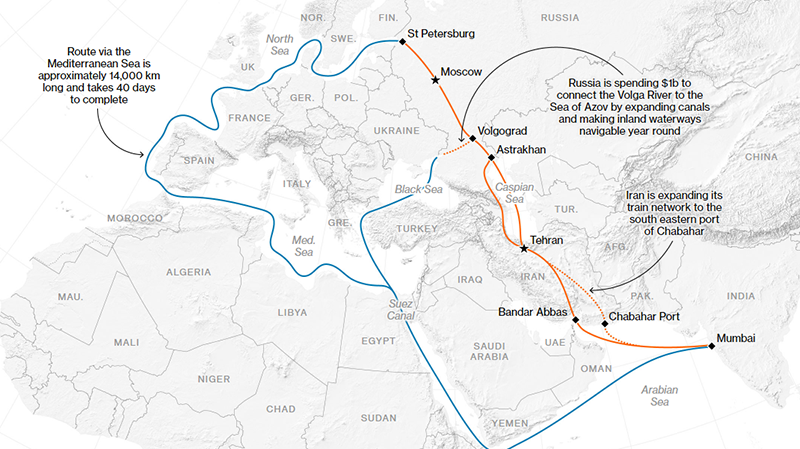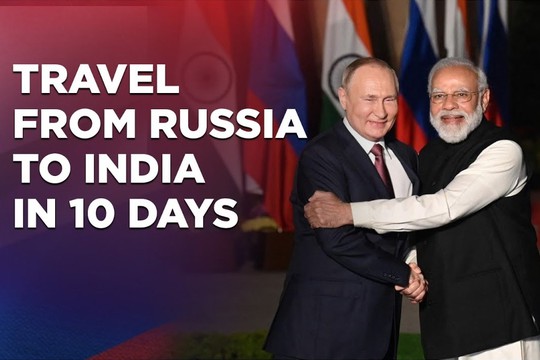For centuries, trade with Europe was the main pillar of Russia’s economy. The war in Ukraine ended that, with Western sanctions and other restrictions increasingly cutting Russia off from European markets. In response, Moscow has expanded ties with the countries more willing to do business with it — China to the east, and, via a southern route, India and the countries of the Persian Gulf, ‘The New York Times’ notes.
That southern route has now become a focus of Russian policymakers as they try to build infrastructure for their plans to pivot away from the West for good. The effort faces challenges, including questions over financing, doubts over the reliability of Russia’s new partners, and threats of Western sanctions targeting countries that trade with Russia.
A key part of the southern plan is a 100-mile $1.7 billion railway set to begin construction this year that would be the final link in a route between Russia and Iranian ports on the Persian Gulf — providing easy access to destinations like Mumbai, India’s trading capital. Russia has agreed to loan Iran $1.4 billion to finance the project.
Russia has found numerous ways to skirt the Western trade restrictions, bringing in things like machinery from India and arms from Iran, as well as a host of consumer goods — often through Gulf countries and Turkey — that the government sees as crucial for showing Russians that it can maintain living standards during a time of war.
The Russian government sees the railway project through Iran — and another line it hopes to restore that would provide access to Turkey — as essential for locking in and speeding the flow of all such imports into the country. It is also seen as critical for stepping up exports of the Russian natural resources that are critical for the economy.
President Vladimir V. Putin of Russia has said that the new route will cut the time for cargo to travel to Mumbai from St. Petersburg to only 10 days, from 30 to 45 days now. Russian officials are calling it a “breakthrough revolutionary project” that will compete with the Suez Canal.
It will also complement Russia’s trading routes toward China, currently its largest trading partner, as those reach overcapacity. Since 2021, just before the full-scale invasion of Ukraine in February 2022, Russia’s trade with China has soared about 63 percent, to more than $240 billion in 2023, according to Chinese figures.
Trade is also surging with India, reaching $65 billion, more than four times what it was in 2021. Russia’s trade with both countries in 2023 surpassed its prewar trade with the European Union, which stood at $282 billion in 2021.
The new railway will link two Iranian cities, Astara and Rasht, connecting tracks between Iran and Azerbaijan to the north, and then to the Russian railway grid. When finished — the new link is expected to be completed in 2028 — the resulting “North-South Transport Corridor” will stretch unbroken for more than 4,300 miles, out of reach of Western sanctions.
From Iranian facilities on the Persian Gulf, Russian traders will have easy access to India, as well as to destinations like Saudi Arabia, the United Arab Emirates, Pakistan and beyond.
In 2023, trade volumes across the route increased by 38 percent over 2021, according to Andrei R. Belousov, Russia’s deputy prime minister for the economy, and could triple by 2030.

Work on a long-planned shipping route connecting Russia with the Middle East and South Asia is moving forward as sanctions-hit Moscow seeks alternative markets for its products, creating a wide-ranging geopolitical ripple effects, writes Asia Nikkei.
The 7,200-kilometer International North-South Transport Corridor will run from St. Petersburg in northwestern Russia to ports in southern Iran, and from there to Mumbai. This will provide a shipping route that bypasses Europe and is less than half as long as the current standard path through the Mediterranean Sea and the Suez Canal.
The corridor has three routes between Russia and Iran. The main western route passes through Azerbaijan via rail and road, while the central route transits through the Caspian Sea by ship and the eastern path follows the Caspian Sea's eastern shore.
The western route in particular has seen substantial progress. Azerbaijan's Ministry of Digital Development and Transport told Nikkei that rail freight grew roughly 30% last year, while road freight rose 35% to 1.3 million tonnes. It sees total freight traffic potentially reaching 30 million tonnes per year.
Azerbaijan is rushing to build domestic infrastructure to boost shipping on the western route. The country plans to construct a railway and road crossing the Aras River, which runs along its border with Iran, and a shipping terminal in the border region is being expanded, with work slated to finish in the third quarter of this year, according to the transport ministry.
A four-lane toll road connecting the Azerbaijani capital of Baku with the Russian border opened in October, following the March 2023 opening of a customs checkpoint in the area.
"The North-South Transport Corridor will attract mutually beneficial trade and investment, and open up new possibilities for cooperation between countries," the ministry said.
Though plans for the corridor were first agreed on by Russia, Iran and India back in 2000, recent geopolitical shifts have helped push the project forward. Western sanctions imposed on Russia after its invasion of Ukraine have Moscow turning toward Asian and Middle Eastern export markets, and sanctions have driven Iran closer to Russia and Asian countries as well.
Moscow and Tehran signed an agreement last May to build a railway in northern Iran that will fill in a long-missing link in the route.
Providing a further boost to the corridor is the growing danger of shipping from Europe to Asia via the usual Suez Canal route, as pro-Iranian Houthi rebels attack commercial ships in the Red Sea.
"Given what is seen in the Red Sea region, the North-South [corridor] will gain global significance," Russian Deputy Prime Minister Alexei Overchuk told Russian media in January.
It is "in the interest of the global economy that this corridor progresses," Indian External Affairs Minister S. Jaishankar said after a meeting in December with his Russian counterpart.
The project has affected military developments in the region as well. Iran, which would also benefit from developing the corridor, has supplied Moscow with numerous drones and other equipment.
And Azerbaijan's closer relationship with Russia appears to have given it a crucial advantage in its conflict with neighboring Armenia.
The North-South corridor has "heightened Azerbaijan's strategic importance to Russia," an Armenian political commentator said.
read more in our Telegram-channel https://t.me/The_International_Affairs

 11:28 15.03.2024 •
11:28 15.03.2024 •























